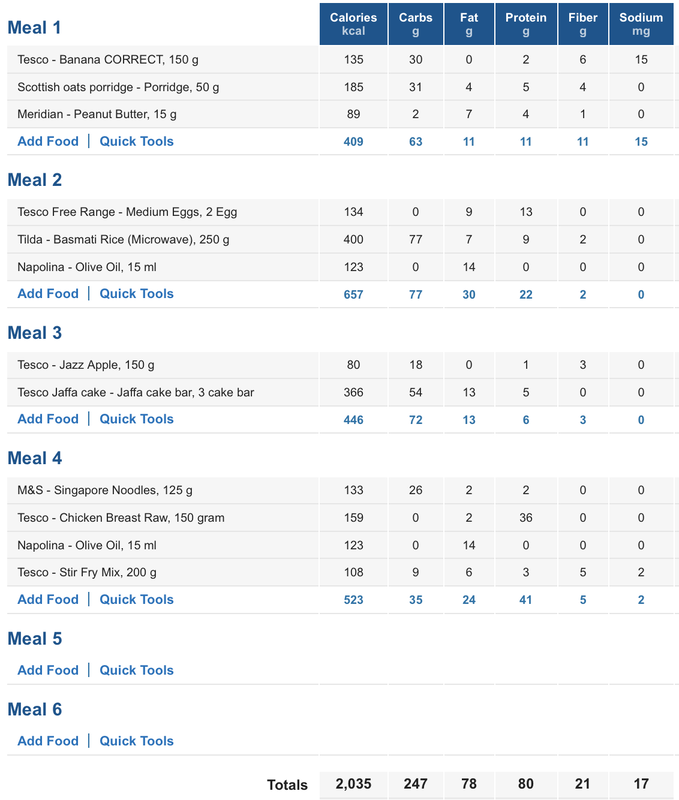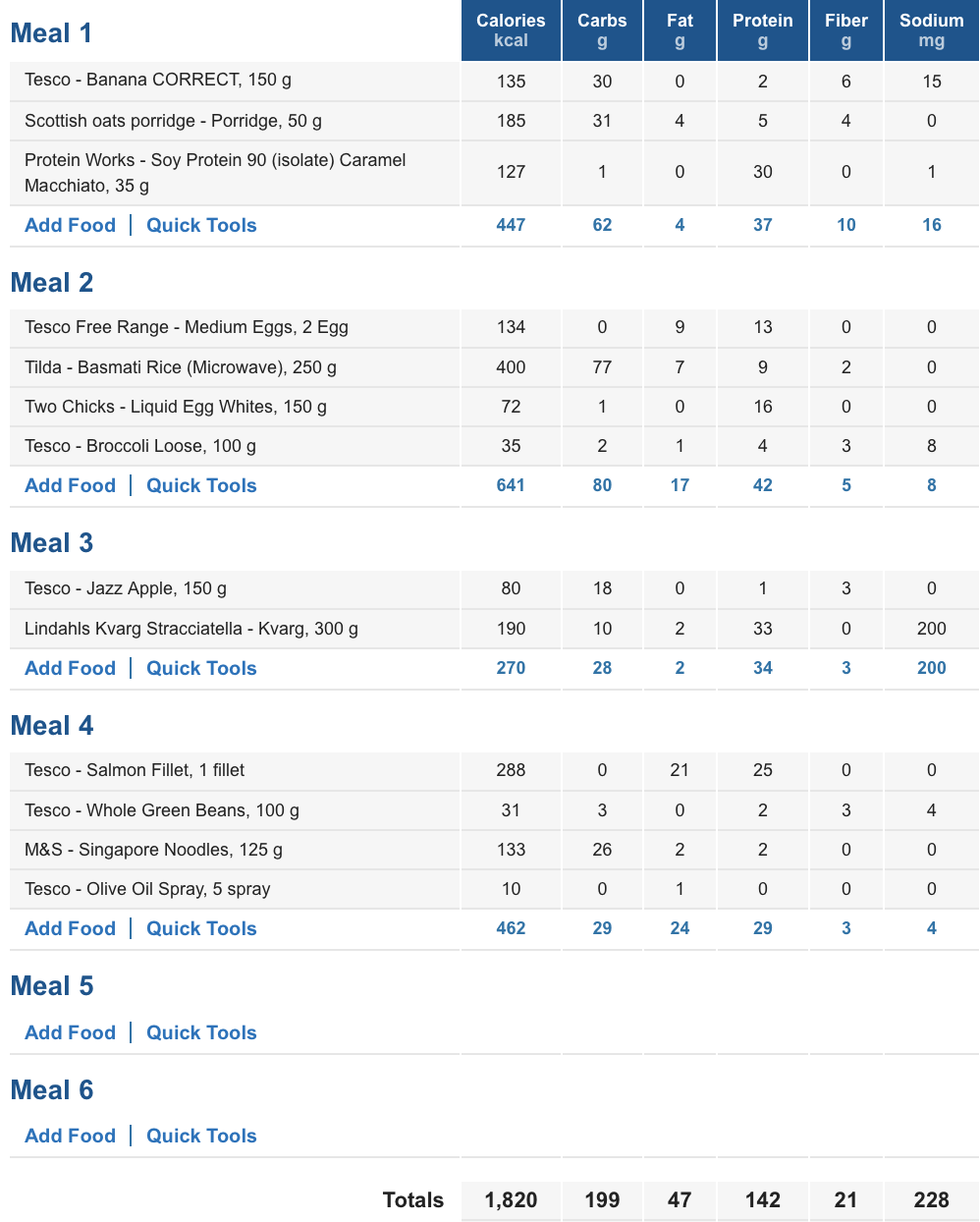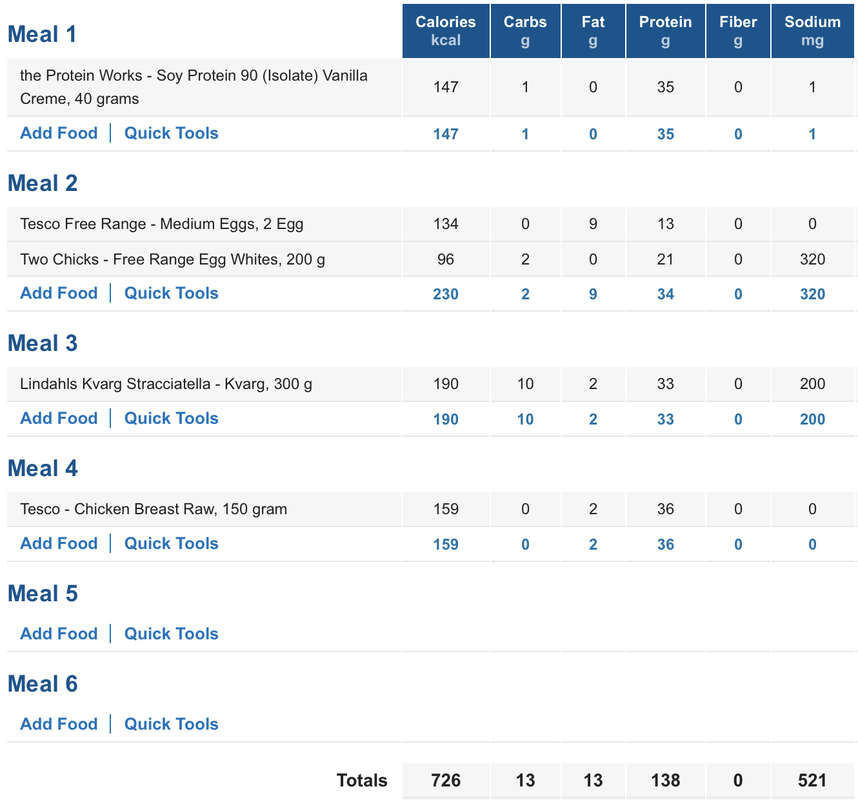What’s the two things they tell you are healthiest to eat? Chicken and fish. You know what you should do? Combine them, eat a penguin. Working out your calorie and protein targets is relatively easy. Any free online calculator can do that for you. Actually hitting those targets? Not so much. That’s where this article comes in, covering four ways to hit your calorie and protein targets every day, without fail. Two of these strategies will apply to you if you have the time to pre-track your food. The last two will have you covered if you need to track on the fly. Therefore, whichever your experience, you’ll find something of value in this article and, most importantly, you’ll be able to apply it to your own circumstances straight away. Let’s dig in. Strategy #1: Create your own self-made meal plan, using past food logs. This is the first of the two strategies aimed at people who wish to pre-track their nutrition. With the following step-by-step method, you’re going to learn how to create a simple self-made “meal plan” that ticks these boxes:
Step 1. Download a calorie-tracking app of your choice and start tracking everything you eat and drink every day for at least three to seven days. At this stage, don’t worry about hitting specific numbers yet; you’re simply collecting information on your current habits. Whenever possible, log your food and drinks before you have them. This is a great habit to develop for the future. When you have targets to hit, logging each meal before you eat it, gives you time to check if you’re staying within said targets. Step 2. When you have at least three days’ worth of entries, choose the day that came closer to hitting your calorie target. For example, your chosen food log entry may look something like this: Assuming your calorie target is 1800 and your protein target is 120 gr, you’re currently overshooting calories, undershooting protein, and you could do with a bit more vegetables. Copy this entire log from the original date into tomorrow’s empty slot. Step 3. Delete any extras that take you over your calorie target, or that prevent you from hitting your protein target, such as snacks, sauces, dressings, etc. If you enjoy eating bigger main meals – breakfast, lunch, and dinner – start by removing some snacks. On the other hand, if you prefer substantial snacks, chip away at the main meals. Step 4. Include more fruit, vegetables, and protein sources, using the calories from the deleted extras. Aim for at least two fistfuls of vegetables or fruit + 20 to 40 gr of protein in the three main meals and at least one snack. If you want to read more about the best way to distribute your protein across the day for muscle growth, check out this article. The simplest way to add protein is to increase the size of an existing portion. For example, if you had 80 gr of chicken for lunch (88 calories, 19 gr of protein), increase this to 100 gr (110 calories, 24 gr of protein). Step 5. If you’ve removed as many extras as you can, but you’re still struggling to eat enough produce and protein, replace some foods with their lower-calorie version. These are some examples:
This is an example of what your meal plan can look like after these adjustments: The changes made are minimal:
Step 6. When you’ve created a meal plan that fulfils your calorie and macronutrient requirements, as above, you can repeat this process to create another one with different food sources in order to add more variety to your diet. You can then alternate the two meal plans. Step 7. As you become more experienced, and learn more about food composition, you can start swapping food sources with a similar nutrient profile. For example, you can swap chicken breast for egg whites (both low-fat protein sources); bread for pasta (both carbohydrate sources); or nuts for avocado (both fat sources). All you need to do is adjust the portion size to match your calorie requirements. Strategy #2: Protein first If you’re struggling to meet your daily protein target, or if you want to pre-track your food, but you don’t have time for Strategy #1, this is going to be your favourite method. Step 1. Open an empty food log entry and add in all of your protein sources first. Include 20 to 40 gr of protein at least four times per day, as described in this article. When you’re done, your food log will look similar to this: Assuming your goal is 1800 calories, you can now “populate” the remainder of the log with 1000 calories’ worth of a combination of carbs and fats, depending on your specific macronutrient needs. You can do this right after pre-tracking your protein, or you can add carbs and fats as the day goes on and you choose what to eat meal to meal.
As an example, based on the four meals pictured above, you could divide 1000 by 4, which is 250, and add 250 calories’ worth of food to each of these protein servings. Strategy #3: Only pre-track your last meal of the day. This is the first of two strategies that will be better suited to someone who doesn’t have time to pre-track their calories. Step 1. Track all of your meals on the fly, except for the last one. Step 2. Before you start making your final meal, look at how many calories you have left, and how much protein you need to hit your protein goal. Step 3. Devise a meal that fits these calorie and nutrient targets. If you’re new to managing your nutrition, expect to make some awkward mistakes, such as eating so many carbs and fats throughout the day that you only have 200 calories left and 50 gr of protein yet to eat at the end of the day. However, the longer you track for, the wiser you’ll become to these errors, so, in the long run, this method can be just as educational and successful as the first two strategies. Strategy #4: Aim for a per-meal target, not a daily target. If you’re tracking on the fly, focusing on your nutrition meal by meal can often be easier than trying to hit an overall daily target. Let’s go through a practical example, assuming your goals are 1800 calories and 120 gr of protein per day. Step 1. Choose the total number of meals you’re going to have, including snacks. Let’s say you pick three meals (breakfast, lunch, dinner) and some snacks, which can be grouped together for simplicity. Step 2. Distribute your calories evenly across these meals. The easiest distribution would be: 1800 : 4 = 450 calories for each meal and for all the snacks put together However, many people like to have bigger meals and a smaller amount of calories allocated for their snacks. In this case, first choose how many calories to spare for the snacks, for example 200 in total for all of them. 1800 – 200 = 1600 1600 : 3 = 533 calories for each main meal Step 3. Distribute your protein so that you’re having at least four servings of 20 to 40 gr to maximally stimulate muscle protein synthesis multiple times across the day. If your goal is 120 gr of protein per day, the math looks like this: 120 : 4 = 30 gr of protein four times per day Step 4. Putting it all together, you can now track on the fly, but you need to make a conscious effort to make food choices that will enable you to hit your protein target without overshooting your total calorie target. You can accomplish this even if you’re eating out. By tracking your chosen meal before you order it, you can check that it meets your per-meal targets. If it doesn’t, you have two options: you can either go ahead and order it, then use Strategy #3 to ensure you’re still nailing your daily targets; or you can change your order to something that falls within your per-meal guidelines. Here you can read a more in-depth article on how to estimate calories when eating out. Practical Takeaways Depending on whether you choose to pre-track your food or do it on the fly, you have a choice of four strategies to nail your nutritional targets:
Thanks for reading. May you make the best gains. To receive helpful fitness information like this on a regular basis, you can sign up for my newsletter by clicking here.
0 Comments
Your comment will be posted after it is approved.
Leave a Reply. |
Nikias TomasielloWelcome to my blog. I’m an online fitness coach with a passion for bodybuilding, fantasy, and bread. Want to work with me? Check out my services!Archives
May 2024
Tags
All
|
Follow me on social media |
Get in touch |
© 2018-2023 Veronica Tomasiello, known as Nikias Tomasiello – All rights reserved





 RSS Feed
RSS Feed